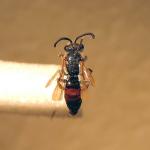Sphecodes dimidiatus von Hagens, 1882; Sphecodes atratus von Hagens, 1882; Sphecodes nigritulus von Hagens, 1882; Sphecodes murithianus Frey-Gessner, 1903; Sphecodes pilicornis Meyer, 1922
This is a very similar bee to the common Sphecodes geoffrellus (Kirby) and confusion, particularly in the female, most probably occurs.
This bee, though scarce, is most frequent in south-east and eastern England. It is not known from Wales, Scotland or Ireland.
Abroad, a widespread species from Finland and Denmark, east to Samos and southern Turkey, Sultan Daglari; south to North Africa (A W Ebmer, pers. comm.). In central Europe it can be locally common though sporadic (S Roberts, pers. comm.).
This species was classified as Nationally Notable/Nb (now known as Nationally Scarce) by Falk (1991).
A species of sandy habitat and frequently found on heathland.
Univoltine, the female flying from late April to August and the male from July to September.
This bee is most often reported to be a cleptoparasite of Lasioglossum nitidiusculum (Kirby) but other similar, small species such as Lasioglossum parvulum (Schenck) may be implicated as additional hosts. A female was taken coursing along and inspecting holes in an old ragstone wall in Kent, in which Lasioglossum smeathmanellum (Kirby) was nesting, another possible host (pers. obs.). Details of the parasitic behaviour do not appear to have been reported in the literature.
Flower visits, for nectar only, are most often to plants of the daisy family, although other families are additionally used in continental Europe (S Roberts, pers. comm.).
No data available.
2016


